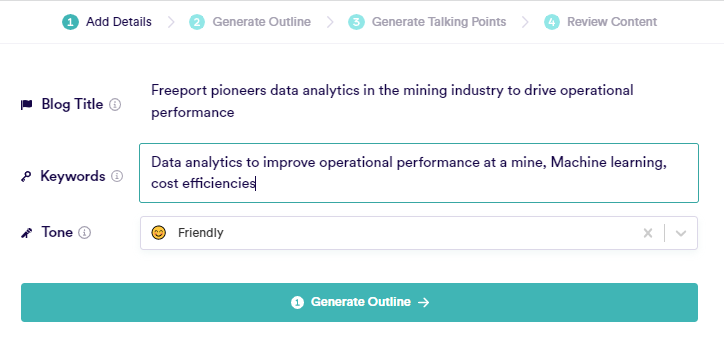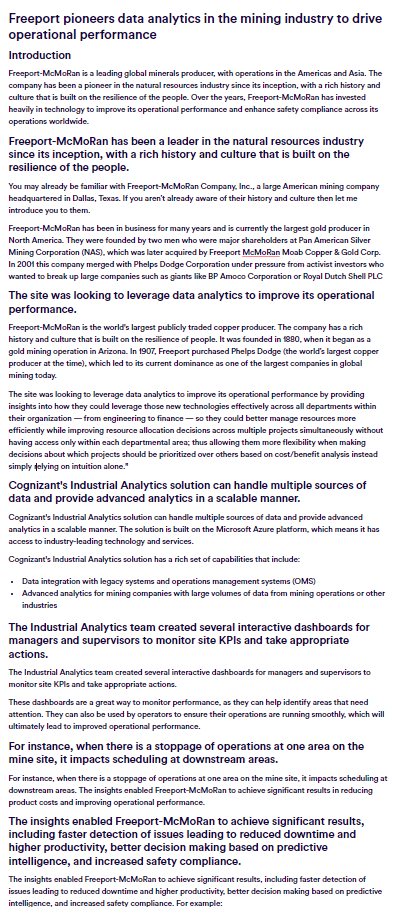CopyAI: Applying natural language processing to content creation

Save time and improve your creativity when writing copy using NLP algorithms with CopyAI
CopyAI is an AI-powered marketing tool that automatically generates human-like marketing copy in minutes. The user inputs what type of copy he/she is trying to create and a few sentences of context, and CopyAI utilizes GPT-3 models to autogenerate content. The copy use-cases supported by the platform include digital ad copy, social media content, website content and blog writing. Over 3 million professionals use CopyAI, and the company boasts blue-chip customers including Microsoft, Ebay, Ogilvy and Nestle. CopyAI features 90+ content creation tools and supports 25+ languages.
CopyAI got early access to OpenAI’s GPT-3 natural language processing algorithm in 2021 and built on these models to serve marketing and content creation use-cases. According to their website, GPT-3 is trained on 10% of the Internet content (scanning trillions of words including websites, news articles, research papers and digitalized books) and can generate text based on specific context provided by the user.
The tool benefits from the classic Machine Learning flywheel: the more content is created and edited on the internet, the more knowledgeable the AI models become, making the tool increasingly accurate and beneficial to its users.
Value creation:
The painpoint that CopyAI’s founders sought to tackle at its inception was the challenge that several entrepreneurs and marketing managers face when having to write quality copy on a recurring basis: generating new, creative content can be challenging and very time-consuming.
CopyAI value proposition is two-fold: i) it saves content creators meaningful time by generating multiple options of content in a matter of seconds, which can then be edited and polished by the user; and ii) it generates several outputs using the same inputs, assisting copy writers in the creative process when facing the blank page.
Users’ reviews of CopyAI are overwhelmingly positive, and with over 3 million users the company has clearly achieved product-market-fit and is delivering on its customer value proposition through a user-friendly interface. I interviewed a marketing manager for a restaurant group who uses it daily to write social media content, marketing emails and digital advertising copy. Her feedback was that CopyAI has helped speed her creative process and improved her efficiency, allowing her to focus a greater portion of her time on higher-value tasks such as managing customer relations and ideating new events for the group’s restaurants.

The below video illustrates the power of the tool, which can generate multiple outputs with few contextual inputs from users. Moreover, the algorithm allows users to choose the tone for the generated content (e.g. friendly, funny, professional, etc.) and ensures that the output is grammatically correct. The latter feature is particularly helpful to content creators who are writing copy in different languages to their own.
More ambitious use cases include the blog writing tool. I tested this function using as an input the title for my first blog for this class and a few keywords including data analytics, operational performance, cost efficiencies, and machine learning. Within minutes CopyAI generated an 800+ word blog writing in human-like text (see below). The power of this tool for this type of applications has rightly risen concerns about fraudulent academic essay writing and copyright.


Value capture:
CopyAI captures value through a subscription freemium model: the more content generated by the user, the higher the subscription fee. Users can generate 2,000 words per months for free (without access to premium features), and premium subscription prices range from $49/month for 40k words/month to over $300/month for unlimited content creation.
The current value capturing model is simple and profitable for the company, which reported recurring revenues of $2.4M last June. The rapid growth in paid-subscriptions and revenue has attracted tier-1 venture capital firms to invest in the company, including Sequoia and Tiger Global.
CopyAI could explore new use cases for its models outside of marketing to expand its revenue base and target new markets, either by directly pursuing new end-markets or by licensing its models to other platforms focusing on non-competing use cases.
The future of CopyAI and opportunities
Given CopyAI’s models usage flywheel (i.e. as more datasets and content becomes available to train the models, the more powerful these become), it is highly likely that the tool will get increasingly better at delivering its customer value proposition. CopyAI has already been successful at making simple, everyday copywriting faster and more efficient, and they will only get better at this.
One opportunity for the company is to continue to move upmarket and compete with advertising agencies at delivering higher value-add marketing tools and copy to its customers. However, GPT-3-based models have limitations and constraints that make me question if CopyAI has the capabilities to write more complex copy that requires greater creativity and that is currently written by advertising executives at marketing agencies.
Ultimately, CopyAI’s GPT-3 powered models generate copy based on patterns learned from existing text available on the internet. This has led some critics to downplay the true “intelligence” of these models and label CopyAI and large language models as being “stochastic parrots”, unable to produce truly original content. Moreover, the current CopyAI tools continue to require significant human supervision, both on the context input side and on the output selection and editing side.
If CopyAi wishes to continue to move upmarket in the digital marketing vertical and move beyond providing basic AI-generated social media captions and product descriptions, it will have to complement its AI models with human advertising professionals that can assist its users to produce higher value and more complex content.
So far, the human capital of the company is focused on technology and AI experts that have developed and trained models and built the platform. The organization may have to expand its creative talent and resources by hiring advertising experts to move upmarket and increase the value delivered to its marketing customers. The combination of cutting-edge AI technology with best-in-class marketing and creative talent might just provide the right ingredients to create a true disruptor in the marketing industry.
Sources:
OpenAI; https://openai.com/blog/gpt-3-apps/
A.I. Is Mastering Language. Should We Trust What It Says?; NY Times; https://www.nytimes.com/2022/04/15/magazine/ai-language.html
https://www.youtube.com/watch?v=5zj4SS5p0zU
CopyAI review; https://becomeawritertoday.com/copy-ai-review/#:~:text=Simply%20click%20on%20the%20one,able%20to%20generate%20unlimited%20writing.
Primary interview with Marketing Manager of the Dinex Group (restaurants group based out of New York); 28 November 2022. Crunchbase; https://www.crunchbase.com/organization/copyai



Very interesting post, Carlos — thanks for sharing! A few thoughts:
– When I wrote about Grammarly in my first blog post for this class, I pondered whether Grammarly is truly a whole product or just a feature. Copy.ai’s application of NLP/GPT-3 takes what Grammarly is doing a step further in a way that provides a ton of immediately-visible value for users, which is very impressive
– However, the ethical concerns are real, as having a paid service could provide some individuals (students, applicants…) an advantage in creating content more efficiently and exclude those who do not have the access/resources to pay
– In terms of our class discussion today, I think Copy.ai is creating system-wide change, as content-focused roles/teams (e.g., content marketers, ghost writers, etc.) no longer have to be centered around the drafting process and can re-organize their time towards cutting-edge research or other creative (vs. mechanical) exercises
This tool sounds awesome! I’ve been curious about more professional uses of GPT-3 since its release; I didn’t expect this would have so much traction already including at large companies. I like how it has very well defined use cases (blogs, website copy) and multiple languages in which they can iterate and continue to improve the model, particularly if this is used in professional settings (versus playing around with fictional stories with other open language models). I agree with you that this may not be best suited for truly original content but rather as an augmentation and convenience tool for existing creative humans, probably similar to the roll of DALL-E 2 today. One concern I get from AI-generated text is about our long-term prospects: if the majority of content in the internet becomes AI-generated, we will be flooded with information that gets reinforced by a self-perpetuating cycle of web crawlers capturing and feeding AI-text to generate further AI-text in the future — it does not sound very appealing.
Funny enough, my next suggested Youtube video from CopyAi was “Write a 1000 Word blog in minutes with AI” — Carlos, do you have something to confess for this assignment? Perhaps it’s not there yet, but future HBS generations may be taking note.